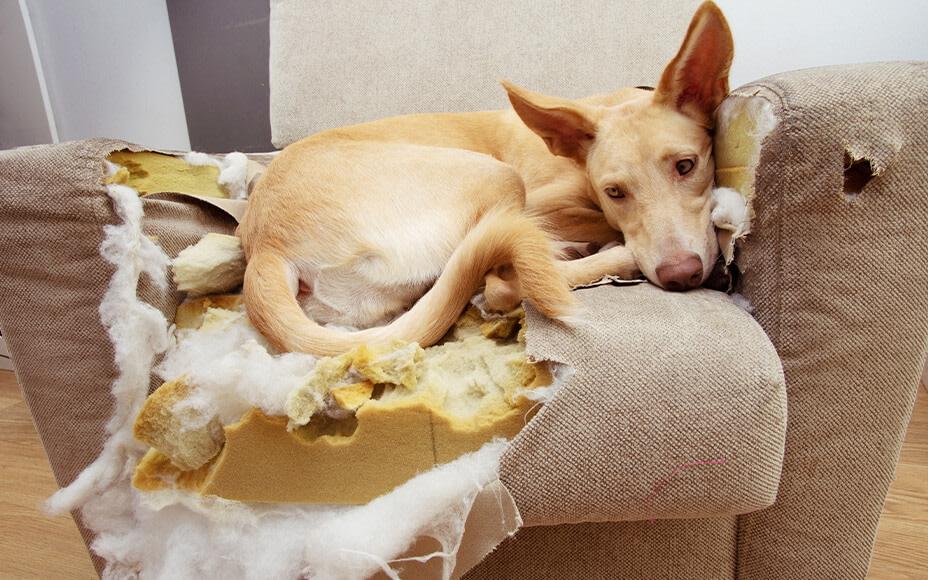Is your dog struggling to stay alone? It might be suffering from separation anxiety. We explain how to recognize the fear and what you can do about it.
What is Separation Anxiety in Dogs?
As the name suggests, separation anxiety in dogs is the fear of being separated from their caregivers. This usually refers to spatial separation, especially when the dog has to stay alone.
Causes: What Causes Separation Anxiety in Dogs?
The reasons for separation anxiety in dogs can vary. Three possible causes might include:
Inherent Difficulty with Being Alone:
Some dogs have no problem being alone “by nature.” Others, however, may start showing difficulties with spatial separation from their caregivers right from the puppy stage. Minor separations, like leaving the dog alone in the living room while you fetch something from the kitchen, may become challenging for them.
These dogs typically display signs of difficulty with spatial separation from their caregivers in everyday situations. Many owners may not notice these subtle signs, only realizing the seriousness of the issue when attempting to leave the dog alone at home.
Lack of Learning to Be Separated:
Another possible cause is that your dog simply never learned that it’s okay to be alone. When a puppy first arrives, we prefer being with him around the clock. While this is cute, it can lead to difficulties when leaving the dog alone, especially if the dog is already showing signs of spatial separation anxiety within the home.
Therefore, it is crucial to start practicing being alone as early as possible. If the whole concept seems more challenging than expected, seek assistance from experienced trainers and work together to address the issue.

Negative Past Experiences:
Dogs, especially those adopted from previous owners or rescue situations, often come with a history. They might have had various experiences that left a mark on them. Dogs from shelters may carry different baggage with them. Once these dogs get accustomed to a new primary caregiver, they might find it challenging to stay alone. Again, consulting experienced professionals is crucial to understanding and addressing these issues.
Signs of Separation Anxiety in Dogs
In general, signs of separation anxiety in dogs are usually quite clear. However, it’s important to note that there may be other causes for the mentioned behaviors, and the issue of being left alone might be different. Loss of control, for example, can manifest in very similar behavioral abnormalities. Therefore, it is even more critical to consider the problem in context and work on it collaboratively with experienced trainers.
The following signs may indicate separation anxiety:
- Loud barking, whining, whimpering
- Jumping at the door, scratching
- Urinating or defecating inside the house
- Destructive behavior towards objects
- Heavy panting and drooling
- Roaming around the house, restlessness
- Excessive licking and chewing on paws

Assistance: Helping Your Dog Overcome Fear
When dealing with a profound and complex issue like separation anxiety, a step-by-step, patient training tailored to the dog-human team usually helps the most. Separation anxiety is linked to trust and security and is not something that can be fixed with a toy or a chew treat.
It’s essential to understand that your four-legged companion is not barking, destroying things, or having accidents on the carpet out of malicious intent. On the contrary, a dog with separation anxiety is extremely stressed, frustrated, and fearful when left alone. The goal of the training should be to reduce the stress associated with being alone and teach the dog to be relaxed even without your presence.
Crucially, before starting the training, have your dog thoroughly checked by veterinarians. Diseases, pain, or hormonal imbalances can also cause stress in your dog.
Whether your dog has successfully undergone a veterinary examination or has managed to stay alone wonderfully – the appropriate reward should not be overlooked. Our delicious snacks have everything a dog’s heart desires.
Various Training Approaches for Separation Anxiety
Since every dog-human team is different, and as mentioned earlier, the causes of separation anxiety can be quite diverse, you need to find a training approach that suits you. Ideally, engage in discussions with multiple trainers to get an understanding of the training methods they use.
Possible Training Approaches:
Gradual Familiarization with Being Alone
In most cases, desensitization is recommended as a therapeutic method for separation anxiety. The dog is repeatedly exposed to the anxiety-inducing situation in very small doses. The exercise is always completed positively, even before your dog exhibits any signs of anxiety. For a dog with separation anxiety, this might mean leaving the room for just a few seconds and then returning.
It’s evident that this method requires diligence. Often, owners must leave the room several times a day for a few seconds to minutes, come back, leave again, come back, and so on. This exercise is repeated until the dog remains completely relaxed. Only then is the duration of being left alone gradually extended for a few seconds.

Reducing Trigger Stimuli
Simultaneously, so-called trigger stimuli should be desensitized. Trigger stimuli are cues that indicate to your dog that you are about to leave the house, and he has to stay alone. These include the jingling of the house keys, putting on shoes, packing a backpack, opening the front door, and so on. All these actions cause stress in your dog because he knows that every time you jingle the keys, he has to stay alone.
Therefore, here as well: Grab the keys more often and simply place them somewhere else, pack and unpack your handbag, put on your jacket and go to the kitchen – all of this helps your dog not to associate these stimuli with being left alone (= stress).
Establishing Separation Signals
Some dogs may benefit from better understanding that there are times when they have “no access” to you, and nobody is taking care of them through the use of a signal. Such signals could be, for example, a scarf or blanket with a specific scent, an object like a lamp that only turns on when the dog has “time out,” turning on the radio, or a simple word like “calm.” A combination of an object and a word is also possible.
Creating a Fixed Resting Place
Additionally, some dogs find it easier to relax when they don’t have access to the entire house but are assigned a specific resting place. A fixed resting place could be a particular room like a bedroom, living room, or hallway. Some dogs are overwhelmed even by this size, and they need something smaller, like a dog crate or a cave-like bed. Especially insecure and fearful dogs benefit from space constraints and a fixed retreat.


